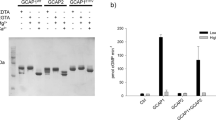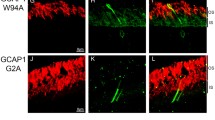Abstract
Cone dystrophy-related mutations in guanylate cyclase-activating protein 1 (GCAP1) are known to cause severe disturbance of their Ca2+-sensing properties affecting also their regulatory modes. However, crucial biochemical properties of mutant GCAP1 forms have not been fully elucidated and regulatory parameters of GCAP1 mutants have not been considered within the context of a comprehensive description of the phototransduction cascade kinetics. We investigated therefore the structure–function relationships of four dystrophy-relevant point mutations in GCAP1 harboring the following amino acid substitutions: E89K, D100E, L151F, and G159V. All mutations decrease the catalytic efficiency in regulating the target guanylate cyclase and decrease the affinity of Ca2+-binding in at least one, but in most cases two EF-hand Ca2+-binding sites. Although the wild type and mutants of GCAP1 displayed large differences in Ca2+-binding and regulation, circular dichroism (CD) spectroscopy revealed that all proteins preserved an intact secondary and tertiary structure with a significant rearrangement of the aromatic residues upon binding of Ca2+. To gain insight into the dynamic changes of cyclic GMP levels in a photoreceptor cell, we incorporated parameters describing the regulation of target guanylate cyclase by GCAP1 mutants into a comprehensive kinetic model of phototransduction. Modeling led us to conclude that the contribution of GCAP1 to the dynamic synthesis of cyclic GMP in rod cells would depend on the expression level of the wild-type form. Although the synthesis rate controlled by GCAP1 remains at a constant level, in the case of high expression levels of cone-dystrophy GCAP1 mutants it would not contribute at all to shaping the cGMP rate, which becomes dynamically regulated solely by the other present Ca2+-sensor GCAP2.





Similar content being viewed by others
References
Pugh EN Jr, Lamb TD (2000) Phototransduction in vertebrate rods and cones: molecular mechanisms of amplification, recovery and light adaptation. In: Stavenga DG, DeGrip WJ, Pugh EN Jr (eds) Handbook of biological physics, vol 3. Elsevier Science BV, Amsterdam, pp 183–255
Korenbrot JI (2012) Speed, sensitivity, and stability of the light response in rod and cone photoreceptors: facts and models. Prog Retin Eye Res 31:442–466
Koch KW, Duda T, Sharma RK (2010) Ca2+-modulated vision-linked ROS-GC guanylate cyclase transduction machinery. Mol Cell Biochem 334:105–115
Dizhoor AM, Olshevskaya EV, Peshenko IV (2010) Mg2+/Ca2+ cation binding cycle of guanylyl cyclase activating proteins (GCAPs): role in regulation of photoreceptor guanylyl cyclase. Mol Cell Biochem 334:117–124
Senin II, Koch KW, Akhtar M, Philippov PP (2002) Ca2+-dependent control of rhodopsin phosphorylation: recoverin and rhodopsin kinase. Adv Exp Med Biol 514:69–99
Kitiratschky VB, Wilke R, Renner AB, Kellner U, Vadalà M, Birch DG, Wissinger B, Zrenner E, Kohl S (2008) Mutation analysis identifies GUCY2D as the major gene responsible for autosomal dominant progressive cone degeneration. Invest Ophthalmol Vis Sci 49:5015–5023
Behnen P, Dell’Orco D, Koch KW (2010) Involvement of the calcium sensor GCAP1 in hereditary cone dystrophies. Biol Chem 391:631–637
Hwang JY, Lange C, Helten A, Höppner-Heitmann D, Duda T, Sharma RK, Koch KW (2003) Regulatory modes of rod outer segment membrane guanylate cyclase differ in catalytic efficiency and Ca2+-sensitivity. Eur J Biochem 270:3814–3821
Scholten A, Koch KW (2011) Differential calcium signaling by cone-specific guanylate cyclase-activating proteins from the zebrafish retina. PLoS One 6:e23117
Mendez A, Burns ME, Sokal I, Dizhoor AM, Baehr W, Palczewski K, Baylor DA, Chen J (2001) Role of guanylate cyclase-activating proteins (GCAPs) in setting the flash sensitivity of rod photoreceptors. Proc Natl Acad Sci USA 98:9948–9953
Makino CL, Wen XH, Olshevskaya EV, Peshenko IV, Savchenko AB, Dizhoor AM (2012) Enzymatic relay mechanism stimulates cyclic GMP synthesis in rod photoresponse: biochemical and physiological study in guanylyl cyclase activating protein 1 knockout mice. PLoS One 7:e47637
Dizhoor AM, Boikov SG, Olshevskaya EV (1998) Constitutive activation of photoreceptor guanylate cyclase by Y99C mutant of GCAP-1. Possible role in causing human autosomal dominant cone degeneration. J Biol Chem 273:17311–17314
Sokal I, Li N, Surgucheva I, Warren MJ, Payne AM, Bhattacharya SS, Baehr W, Palczewski K (1998) GCAP1 (Y99C) mutant is constitutively active in autosomal dominant cone dystrophy. Mol Cell 2:129–133
Sokal I, Dupps WJ, Grassi MA, Brown J Jr, Affatigato LM, Roychowdhury N, Yang L, Filipek S, Palczewski K, Stone EM, Baehr W (2005) A novel GCAP1 missense mutation (L151F) in a large family with autosomal dominant cone-rod dystrophy (adCORD). Invest Ophthalmol Vis Sci 46:1124–1132
Kitiratschky VBD, Behnen P, Kellner U, Heckenlively JR, Zrenner E, Jägle H, Kohl S, Wissinger B, Koch KW (2009) Mutations in the GUCA1A gene involved in hereditary cone dystrophies impair calcium-mediated regulation of guanylate cyclase. Hum Mutat 30:E782–E796
Dell’Orco D, Behnen P, Linse S, Koch KW (2010) Calcium binding, structural stability and guanylate cyclase activation in GCAP1 variants associated with human cone dystrophy. Cell Mol Life Sci 67:973–984
Olshevskaya EV, Calvert PD, Woodruff ML, Savchenko AB, Makino CL, Ho YS, Fain GL, Dizhoor AM (2004) The Y99C mutation in guanylyl cyclase-activating protein 1 increases intracellular Ca2+ and causes photoreceptor degeneration in transgenic mice. J Neurosci 24:6078–6085
Olshevskaya EV, Peshenko IV, Savchenko AB, Dizhoor AM (2012) Retinal guanylyl cyclase isozyme 1 is the preferential in vivo target for constitutively active GCAP1 mutants causing congenital degeneration of photoreceptors. J Neurosci 32:7208–7217
Hamer RD, Nicholas SC, Tranchina D, Lamb TD, Jarvinen JLP (2005) Toward a unified model of vertebrate rod phototransduction. Vis Neurosci 22:417–436
Dell’Orco D, Schmidt H, Mariani S, Fanelli F (2009) Network-level analysis of light adaptation in rod cells under normal and altered conditions. Mol BioSyst 5:1232–1246
Dell’Orco D, Koch KW (2011) A dynamic scaffolding mechanism for rhodopsin and transducin interaction in vertebrate vision. Biochem J 440:263–271
Invergo BM, Montanucci L, Koch KW, Bertranpetit J, Dell’Orco D (2013) Exploring the rate-limiting steps in visual phototransduction recovery by bottom-up kinetic modeling. Cell Commun Signal 11:36
Koch KW, Dell’Orco D (2013) A calcium-relay mechanism in vertebrate phototransduction. ACS Chem Neurosci 4:909–917
Koch KW, Helten A (2008) Guanylate cyclase-based signaling in photoreceptors and retina. In: Fliesler SJ, Kisselev OG (eds) Signal transduction in the retina, chapter 6. Taylor and Francis/CRC Press, London, pp 121–143
Bradford M (1976) A rapid and sensitive method for the quantitation of microgram quantities of protein utilizing the principle of protein-dye binding. Anal Biochem 73:248–254
Behnen P (2010) Funktionelle Charakterisierung von GCAP1-Mutanten als Ursache erblicher Zapfen-Dystrophien. PhD Thesis. University of Oldenburg, Oldenburg, Germany
Hindmarsh A, Brown P, Grant K (2005) SUNDIALS: Suite of nonlinear and differential/algebraic equation solvers. ACM Trans Math Softw 31:363–396
Peshenko IV, Olshevskaya EV, Savchenko AB, Karan S, Palczewski K, Baehr W, Dizhoor W (2011) Enzymatic properties and regulation of the native isozymes of retinal membrane guanylyl cyclase (RetGC) from mouse photoreceptors. Biochemistry 50:5590–5600
Makino CL, Peshenko IV, Wen XH, Olshevskaya EV, Barrett R, Dizhoor AM (2008) A role for GCAP2 in regulating the photoresponse. Guanylyl cyclase activation and rod electrophysiology in GUCA1B knock-out mice. J Biol Chem 283:29135–29143
Peshenko IV, Olshevskaya E, Dizhoor AM (2008) Binding of guanylyl cyclase activating protein 1 (GCAP1) to retinal guanylyl cyclase (RetGC1). J Biol Chem 283:21747–21757
Lim S, Peshenko I, Dizhoor A, Ames JB (2009) Effects of Ca2+, Mg2+, and myristoylation on guanylyl cyclase activating protein 1 structure and stability. Biochemistry 48:850–862
Acknowledgments
This work was supported by the Deutsche Forschungsgemeinschaft (DFG) to K-WK (KO 948/10-1) and by funds from the Italian Ministry for Research and Education via departmental funds (FUR2012) to DDO.
Author information
Authors and Affiliations
Corresponding authors
Electronic supplementary material
Below is the link to the electronic supplementary material.
Rights and permissions
About this article
Cite this article
Dell’Orco, D., Sulmann, S., Zägel, P. et al. Impact of cone dystrophy-related mutations in GCAP1 on a kinetic model of phototransduction. Cell. Mol. Life Sci. 71, 3829–3840 (2014). https://doi.org/10.1007/s00018-014-1593-4
Received:
Revised:
Accepted:
Published:
Issue Date:
DOI: https://doi.org/10.1007/s00018-014-1593-4




